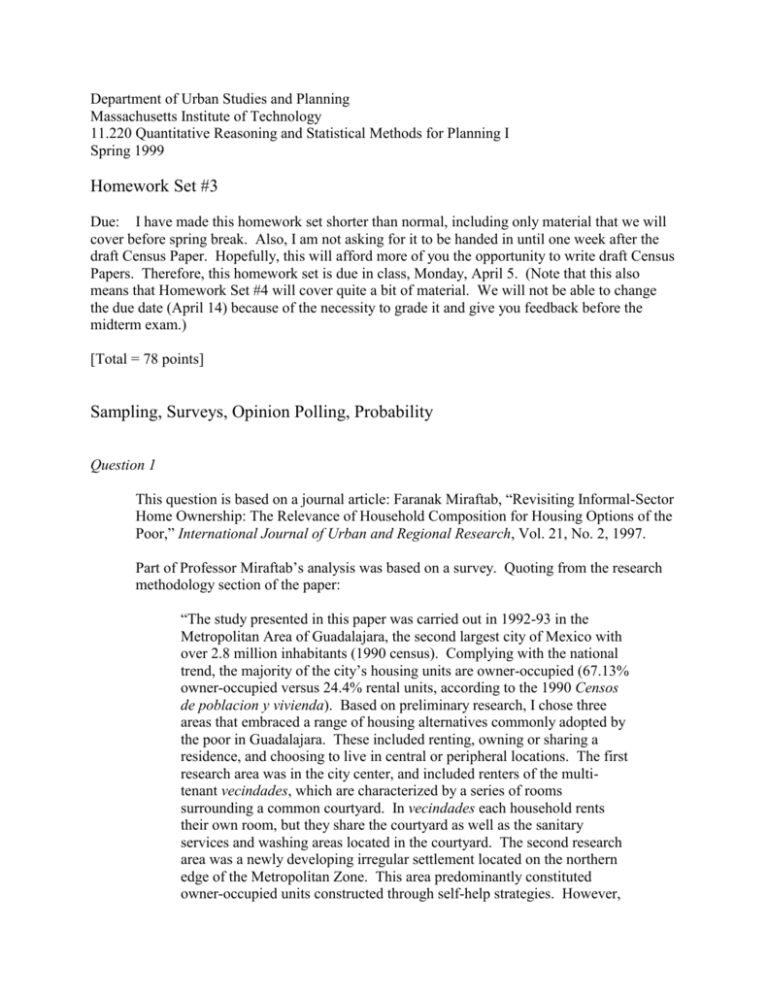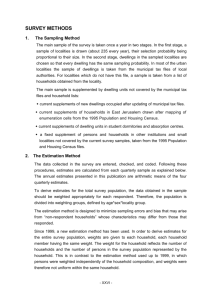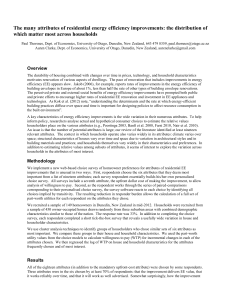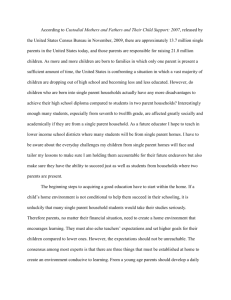Problem Set 3
advertisement

Department of Urban Studies and Planning Massachusetts Institute of Technology 11.220 Quantitative Reasoning and Statistical Methods for Planning I Spring 1999 Homework Set #3 Due: I have made this homework set shorter than normal, including only material that we will cover before spring break. Also, I am not asking for it to be handed in until one week after the draft Census Paper. Hopefully, this will afford more of you the opportunity to write draft Census Papers. Therefore, this homework set is due in class, Monday, April 5. (Note that this also means that Homework Set #4 will cover quite a bit of material. We will not be able to change the due date (April 14) because of the necessity to grade it and give you feedback before the midterm exam.) [Total = 78 points] Sampling, Surveys, Opinion Polling, Probability Question 1 This question is based on a journal article: Faranak Miraftab, “Revisiting Informal-Sector Home Ownership: The Relevance of Household Composition for Housing Options of the Poor,” International Journal of Urban and Regional Research, Vol. 21, No. 2, 1997. Part of Professor Miraftab’s analysis was based on a survey. Quoting from the research methodology section of the paper: “The study presented in this paper was carried out in 1992-93 in the Metropolitan Area of Guadalajara, the second largest city of Mexico with over 2.8 million inhabitants (1990 census). Complying with the national trend, the majority of the city’s housing units are owner-occupied (67.13% owner-occupied versus 24.4% rental units, according to the 1990 Censos de poblacion y vivienda). Based on preliminary research, I chose three areas that embraced a range of housing alternatives commonly adopted by the poor in Guadalajara. These included renting, owning or sharing a residence, and choosing to live in central or peripheral locations. The first research area was in the city center, and included renters of the multitenant vecindades, which are characterized by a series of rooms surrounding a common courtyard. In vecindades each household rents their own room, but they share the courtyard as well as the sanitary services and washing areas located in the courtyard. The second research area was a newly developing irregular settlement located on the northern edge of the Metropolitan Zone. This area predominantly constituted owner-occupied units constructed through self-help strategies. However, 11.220: Quantitative Reasoning and Statistical Methods for Planning Homework Set #3 Page 2 it lacked basic urban services such as sewerage, pavements, water, and electricity, and had only limited transportation connecting it to the rest of the city. The third research area was a colonia in which I had previously lived and worked on a different research topic. It is located between the other two areas, less than ten kilometers from the city center, and is fairly accessible to other parts of the city. It is an older working class neighborhood, with a mix of renters and owners. Initially formed in the 1950s as an irregular settlement, it had obtained basic urban services over the past four decades. The field research included two phases and employed quantitative and qualitative approaches. In the first phase of research, 90 random surveys were conducted with adult female members of households (30 households in each neighborhood) to explore possible relationships between housing and household variables. For example, the relation between the gender of the household head and the location of the housing (peripheral vs. central), the housing tenure (renting vs. owning), and the residential spatial arrangement (shared vs. single residency) were examined through the survey data….” [6] (a) What type of probability sampling did the author use in this study? Why did she choose this form of sampling instead of one of the other forms? [4] (b) Given this description of the sampling technique used, can you think of any problems that might have crept into the sampling and biased the resulting estimates. (Please concern yourself with bias rather than a lack of precision here.) In a section of the paper entitled, “Research results: links between household composition and housing decisions,” Professor Miraftab reports the following results, making reference to Table 1: “The results of the random survey showed a clear correlation between the housing options adopted by low-income families and the composition of their household based on the gender of the household head. In my sample, households who identified their head as a woman (32.6% of all households) commonly adopted different residential alternatives than those who identified their head as a man. This differential pattern concerned locations within urban space, tenure status and living arrangement. In general, female-headed households were concentrated among renters in the inner-city area and in shared residencies; by contrast male-headed households had a lower concentration in the inner city, were more likely to be home owners and were equally distributed in shared or single-residencies (see Table 1). Of all the female householders in my sample group, 42.9% were residents of the multi-tenant units of the inner city, with 32.1% living in 11.220: Quantitative Reasoning and Statistical Methods for Planning Homework Set #3 Page 3 the peripheral settlement and 25% in the consolidated colonia. This was, however, the reverse for male-headed households, whose concentration was less in the inner-city vecindades (26.7%) than in the two other areas (36.2% in each). Considering the sample group in each area, the survey shows that close to half of all residents (sic) of the inner-city vecindades (42.9%) were headed by women alone. In the peripheral settlement, however, less than a third (32.1%) and in the consolidated colonia only a quarter of all the households (25%) were headed by women. The sample from the three studied areas also indicated that sharing a place of residence was much more common among female- than maleheaded households. Independent of their tenure status as renters or owners, female-headed households were far less likely than male-headed households to live in single-family residencies. Only 28.6% of households with a female head were living in a single-residency setting, whereas half of all male-headed households in my sample lived in such a setting.” Residential tenure was another differential pattern observed in the survey information. Female householders were mostly renters (56%), but male-headed households were mainly home owners (52.8%). The data on ownership status of female householders, however, should be interpreted with caution. For a considerable number of female householders who owned a home, the home ownership had occurred prior to their becoming the head of household. If only those who achieved home ownership as single mothers were accounted for, the percentage of female home owners would be reduced from the recorded 44%, indicating an even greater gap in the ownership status of the two household categories.” Table 1 Distribution of male- and female-headed household by type of housing (numbers in ( ) represent number of respondents) Household Type Location Inner city Peripheral Tenure* Colonia In-between Own Spatial Configuration Rent Maleheaded (58) 27.6% (16) 36.2% (21) 36.2% (21) 52.8% (28) 47.2% (25) Shared & Semishared 50% (29) Femaleheaded (28) 42.9% (12) 32.1% (9) 25% (7) 44% (11) 56% (14) 71.5% (20) Singlefamily residence 50% (29) 28.6% (8) * Calcuation of tenure percentages excludes 5 respondents in my sample who lived for free in accommodation lent to them by a relative or acquaintance who themselves did not live in the unit. Those living in lent houses or ‘casas prestadas’ are neither renters nor owners. 11.220: Quantitative Reasoning and Statistical Methods for Planning Homework Set #3 Page 4 [4] (c) The first sentence of this summary uses the word “correlation,” but no correlation coefficient has been calculated here. How is the author using the word “correlation” in this context? Use the concepts of probability in your answer. [4] (d) The description of the methodology for this project stipulates that 90 households were sampled, 30 in each neighborhood. Yet, this table tabulates fewer than 90 households. In the portion of the table that summarizes location by household type, only 86 households are tabulated. What do you imaging happened to the other four? Should this be of concern to the overall study? [4] (e) In the portion of the table that summarizes tenure by household type only 78 households are tabulated? What has happened here? Is this of concern to the overall study? [8] (f) Create a probability tree that represents all of the probability information contained in the portion of the table that summarizes location by household type. Clearly mark and label all of the nodes and branches, associate the appropriate probabilities with each branch, and calculate the correct joint probabilities for each outcome. [4] (g) From the probability tree, show how one would calculated the probability that an inner-city household randomly selected from these combined samples would be male-headed. (h) At the end of the second paragraph describing the research results are the following sentences (copied from above): “Considering the sample group in each area, the survey shows that close to half of all residents (sic) of the inner-city vecindades (42.9%) were headed by women alone. In the peripheral settlement, however, less than a third (32.1%) and in the consolidated colonia only a quarter of all the households (25%) were headed by women.” [4] [8] What mistake has the author made in both of these sentences? (Note: I am not referring to the incorrect usage of the word “residents” in the first sentence.) (i) So far, the questions that I have asked have focused on relatively minor, technical issues associated with this study. However, in conducting the analysis in Table 1, the author has made one tremendous conceptual error that calls all of her conclusions into jeopardy. What is it? Explain as clearly as possible. 11.220: Quantitative Reasoning and Statistical Methods for Planning Homework Set #3 Page 5 Question 2 Attached is a “National Survey” that was sent to me by the American Farmland Trust. [10] (a) Write a paragraph discussing this survey as an instrument for gathering information about people’s views on these agricultural issues. Be sure to discuss the wording of specific questions as well as the order of the questions. Question 3 Also attached is a survey put together by the Burlington, Vermont Community and Economic Development Office. [6] (a) Comment on the cover page (“Citizens’ Attitudes Toward Burlington’s Future”). Why is all of this information being given to possible respondents? In your view, is it effective? [8] (b) What is the point of conducting what seem to be two different surveys—a Random Sample Survey and an Individual Citizen Response survey? Why can’t the results of the two surveys simply be tabulated together? Be as explicit as possible in your answer. [8] (c) While this is a reasonably designed survey it is possible to criticize some of its elements. What criticisms would you make of the design of this survey instrument to gather information on citizen attitudes toward development in Burlington?







